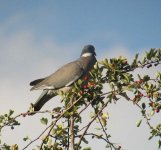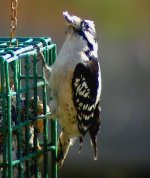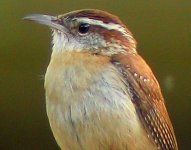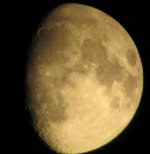-
Welcome to BirdForum, the internet's largest birding community with thousands of members from all over the world. The forums are dedicated to wild birds, birding, binoculars and equipment and all that goes with it.
Please register for an account to take part in the discussions in the forum, post your pictures in the gallery and more.
You are using an out of date browser. It may not display this or other websites correctly.
You should upgrade or use an alternative browser.
You should upgrade or use an alternative browser.
canon powershot a70 and ... ? (1 Viewer)
- Thread starter slawekpar
- Start date
More options
Who Replied?digi-birder
Well-known member
Hi Slawek,
How have you made a mistake? Are you hand-holding the camera to the scope?
You may have been told that the Nikon cameras are the ones to buy for digiscoping, but don't be disappointed with what you have. There may be a way round it.
The Canon A70 was on my shortlist recently when I was thinking of changing FROM the Coolpix 995 as I was not getting very sharp photos with it. Eventually I went for the Canon G3 due to some extra features, but you can digiscope with the A70 in exactly the same way as I do with the G3.
I have seen someone digiscoping with the A70, although they were hand-holding to the scope and getting some very good photos.
I will be posting some info on my setup as soon as I can get some photos together, but basically you could get a lens thread adapter tube to fit around your lens in place of the ring that is there at the moment. See second image on the page at:
http://www.steves-digicams.com/2003_reviews/a70_pg2.html and then make something to fit onto the end of this, as I did.
I made a digiscoping adapter from a piece of plastic plumbing joint and glued a step ring to the end and this then screws onto the extension tube. The size of the plumbing joint makes it fit exactly over my scope eyepiece with no screws needed. The zoomed out lens then gets as close to the scope eyepiece as possible. Although there is some vignetting, this can be cropped out on the computer.
You can see the latest photos taken in Scotland with this setup in my gallery. I should be able to get the full text and photos sorted out over the weekend. Quite a few people have expressed an interest in the setup, as the general assumption is that only the Coolpix cameras work. I made that mistake last year and dashed out to get what everyone else was buying.
As it turns out, and I have mentioned this elsewhere on the forum, I do believe I had a faulty camera, so this is not a complaint about the Nikons altogether. Some people are getting superb photos with them. It's just that you can get good results with cheaper cameras if you are prepared to make some compromises.
Also you can buy some bracket adapters that screw into the tripod screw on the base of the camera and then clamp onto the eyepiece. You then have to perform some adjustments in order to line up the lens and eyepiece. I did try a couple of these and returned them as they were a bit fiddly to use. Some people can get on with them though, so it's a matter of personal choice. Look in the Gallery under the Equipment and Accessories section - there are some examples there.
Don't despair just yet. :t:
How have you made a mistake? Are you hand-holding the camera to the scope?
You may have been told that the Nikon cameras are the ones to buy for digiscoping, but don't be disappointed with what you have. There may be a way round it.
The Canon A70 was on my shortlist recently when I was thinking of changing FROM the Coolpix 995 as I was not getting very sharp photos with it. Eventually I went for the Canon G3 due to some extra features, but you can digiscope with the A70 in exactly the same way as I do with the G3.
I have seen someone digiscoping with the A70, although they were hand-holding to the scope and getting some very good photos.
I will be posting some info on my setup as soon as I can get some photos together, but basically you could get a lens thread adapter tube to fit around your lens in place of the ring that is there at the moment. See second image on the page at:
http://www.steves-digicams.com/2003_reviews/a70_pg2.html and then make something to fit onto the end of this, as I did.
I made a digiscoping adapter from a piece of plastic plumbing joint and glued a step ring to the end and this then screws onto the extension tube. The size of the plumbing joint makes it fit exactly over my scope eyepiece with no screws needed. The zoomed out lens then gets as close to the scope eyepiece as possible. Although there is some vignetting, this can be cropped out on the computer.
You can see the latest photos taken in Scotland with this setup in my gallery. I should be able to get the full text and photos sorted out over the weekend. Quite a few people have expressed an interest in the setup, as the general assumption is that only the Coolpix cameras work. I made that mistake last year and dashed out to get what everyone else was buying.
As it turns out, and I have mentioned this elsewhere on the forum, I do believe I had a faulty camera, so this is not a complaint about the Nikons altogether. Some people are getting superb photos with them. It's just that you can get good results with cheaper cameras if you are prepared to make some compromises.
Also you can buy some bracket adapters that screw into the tripod screw on the base of the camera and then clamp onto the eyepiece. You then have to perform some adjustments in order to line up the lens and eyepiece. I did try a couple of these and returned them as they were a bit fiddly to use. Some people can get on with them though, so it's a matter of personal choice. Look in the Gallery under the Equipment and Accessories section - there are some examples there.
Don't despair just yet. :t:

Hi Slawek,
Welcome to Bird Forum.net.
As Diane said, there are far worse digiscoping cameras than the Canon A** cameras..... I know several digiscopers taking excellent shots with these cameras, though I'm not familiar with the newer A70.
Try it and see, is the best approach.
Regards,
Andy
Welcome to Bird Forum.net.
As Diane said, there are far worse digiscoping cameras than the Canon A** cameras..... I know several digiscopers taking excellent shots with these cameras, though I'm not familiar with the newer A70.
Try it and see, is the best approach.
Regards,
Andy
reg vernon
Member
Using Canon A70 for digiscoping
I have yet to buy an adapter that will enable me to use my camera reliably every time - at the moment it's such a fiddle trying to disgiscope holding the camera to the eyepiece by hand that I've given up doing so until I've found the right adapter. However, the few attempts I've made have yielded good results, apart from vignetting, but that's not a problem as long as the subkject is in the centre of the image as cropping tools etc e.g. in Photoshop, eliminate that as a problem. Attached pic of a pigeon is cropped from an image that was completely circular.
I have yet to buy an adapter that will enable me to use my camera reliably every time - at the moment it's such a fiddle trying to disgiscope holding the camera to the eyepiece by hand that I've given up doing so until I've found the right adapter. However, the few attempts I've made have yielded good results, apart from vignetting, but that's not a problem as long as the subkject is in the centre of the image as cropping tools etc e.g. in Photoshop, eliminate that as a problem. Attached pic of a pigeon is cropped from an image that was completely circular.
Attachments
erniehatt
Well-known member
Hi, don't give up yet, I have had a look at a review of the A70, and it has all the features necessary for digiscoping. My only suggestion is to steer away from the adapter mentioned above, as it does not allow the lens to stay close enough to the lens, this is why it vignettes. I use a Canon A640 and have developed my own sliding adapter, if you make a search for Universal adapter you will find a thread on it with pics.. Good luck Ernie
reg vernon
Member
Digiscoping with Canon A70
Thanks Ernie,
I ordered the Canon lens adapter yesterday from www.DigitalFirst.co.uk. I'm probably going to get something called the F-adapter which seems to screw into the end of the Canon adapter and then clamp around the eyepiece of the scope. In use it looks as though one might be able to rotate the eye piece by slackening the F-adapter, removing the camera, adjusting the focus and subject, and then re-clamping. The price seems reasonable too.
My son is the real birder in the family - he's the guy with the Swarovski spotting scope and Leica bins. I'm the guy that tags along sometimes (e.g. to see nightjars and little owls on Cannock Chase) with my 20x50 cheapo bins and a Piccolo Compact OG 15-45x60 spotting scope, which I am well-pleased with. I got a cracking photo of the moon using it, again hand-held. The Piccolo was marked in the shop as an Opticron Piccolo but when I unpacked it there was absolutely no indication that it had anything at all to do with Opticron. A retailer in Stafford, who was also advertising it as an Opticron, remove the price tag and admitted it was a mistake to call it an Opticron, yet I have since seen a web-site claiming that it is "supplied by Opticron" but not branded as one of their products. Although its often said "you get what you pay for" I have been truly surprised at just how good this scope is. for a beginner like me, it is a perfectly adequate starter scope.
Thanks Ernie,
I ordered the Canon lens adapter yesterday from www.DigitalFirst.co.uk. I'm probably going to get something called the F-adapter which seems to screw into the end of the Canon adapter and then clamp around the eyepiece of the scope. In use it looks as though one might be able to rotate the eye piece by slackening the F-adapter, removing the camera, adjusting the focus and subject, and then re-clamping. The price seems reasonable too.
My son is the real birder in the family - he's the guy with the Swarovski spotting scope and Leica bins. I'm the guy that tags along sometimes (e.g. to see nightjars and little owls on Cannock Chase) with my 20x50 cheapo bins and a Piccolo Compact OG 15-45x60 spotting scope, which I am well-pleased with. I got a cracking photo of the moon using it, again hand-held. The Piccolo was marked in the shop as an Opticron Piccolo but when I unpacked it there was absolutely no indication that it had anything at all to do with Opticron. A retailer in Stafford, who was also advertising it as an Opticron, remove the price tag and admitted it was a mistake to call it an Opticron, yet I have since seen a web-site claiming that it is "supplied by Opticron" but not branded as one of their products. Although its often said "you get what you pay for" I have been truly surprised at just how good this scope is. for a beginner like me, it is a perfectly adequate starter scope.
Paul Corfield
Well-known member
Thanks Ernie,
I ordered the Canon lens adapter yesterday from www.DigitalFirst.co.uk. I'm probably going to get something called the F-adapter which seems to screw into the end of the Canon adapter and then clamp around the eyepiece of the scope. In use it looks as though one might be able to rotate the eye piece by slackening the F-adapter, removing the camera, adjusting the focus and subject, and then re-clamping. The price seems reasonable too.
I used an F-adapter for a few years before moving onto my current set up. I'm not sure I'd want to loosen the screws and remove the F-adapter everytime I wanted to focus the scope. That would be a real pain and far from ideal. The F-adapter works fine on a fixed eyepiece where the scope has a separate focus wheel as you just focus the image on the camera screen. The F-adapter takes time to set up squarely and get the vignette just right. Once set you really need to do the screws up tight and leave it set. There must be a better solution that in the long run would offset the cost.
Paul.
Last edited:
reg vernon
Member
Digiscoping with Canon A70
Paul
You are right - what I meant to refer to was altering the magnification between 15x and 45x which can't be done with the F-adapter fitted for the reason you give. What I've found, using the scope, is that finding the subject is a lot easier at 15x, but if one wants to really bring the subject close in, then one has to centre the subject at 15x, rotate to desired mag level and refocus using the focus ring. Until I have the whole kit, I won't know how it's going to work out for me.
I'm curious - what do you use now? And would I be better off choosing something other than the F-adapter? Your help will be much appreciated.
Paul
You are right - what I meant to refer to was altering the magnification between 15x and 45x which can't be done with the F-adapter fitted for the reason you give. What I've found, using the scope, is that finding the subject is a lot easier at 15x, but if one wants to really bring the subject close in, then one has to centre the subject at 15x, rotate to desired mag level and refocus using the focus ring. Until I have the whole kit, I won't know how it's going to work out for me.
I'm curious - what do you use now? And would I be better off choosing something other than the F-adapter? Your help will be much appreciated.
Paul Corfield
Well-known member
I'm using a fixed focus 24mm William Optics DCL-28 eyepiece which is threaded and I'm using the Foxfoto camera adapter which just screws onto the eyepiece. I have a 17mm Baader Hyperion eyepiece which is also threaded and fits the Foxfoto adapter via the correct step up ring.
For an eyepiece like yours I should think some sort of swing away adapter would be best so that you can switch between 15x and 45x, refocus and then swing the camera back into place. I've never used one so can't offer much more advice than that I'm afraid.
Paul.
For an eyepiece like yours I should think some sort of swing away adapter would be best so that you can switch between 15x and 45x, refocus and then swing the camera back into place. I've never used one so can't offer much more advice than that I'm afraid.
Paul.
Reg,I use a Canon A70 which is my only camera and use it regularly for digiscoping and have done for a number of years. I use a Canon LA-DC52C filter adapter which bayonets onto the front of the camera. This has a 52 mm thread into which I screw a special lens adapter made by LCE which fits neatly over my telescope eye-piece.I use a Leica APO 77 scope and Manfrotto tripod to give good light and steady base. I have recently purchased a cablr release bracket and made my own LCD SHADE both of which are indispensible. I get good results and have got better as I learn and read about the subject and know my cameras limits. Hope this helps.
David
David
I used an A70 for three years, with many different scopes, and always with excellent results. I used the 52mm Canon adapter and coupled it to homemade scope adapters. I am attaching images made with this setup. These were made through a 25x60mm spotting scope that I paid $85.00 for.
Attachments
reg vernon
Member
Digiscoping with Canon A70
Thanks David and Texun - very helpful replies. I'll look up the LCE adapter (London Camera Exchange?). I like Texun's pics. The thumbnail I posted, which compares well technically with Texun's (his is a better composition) was taken of a wood-pigeon perched on a Pyracantha shrub (Firethorn). The shrub is located about 15ft from the back of the house and I positioned the scope, on a tripod, at the minimum focusing distance. I haven't used this scope in the field yet. I go out with my son and there's no point in both of us lugging equipment around - I just take my 20x50 bins and use his scope when he has something to show me.
I was playing with my scope today, trying to take pics of garden flowers just for practice. Strangely, I couldn't get any of my shots to focus properly. I don't know what I was doing wrong because the pigeon pic referred to earlier and the thumbnail of the moon attached below, are both in focus, so I must have got it right sometimes. Zooming in gave me full view pics but none of the shots were in focus.
Thanks David and Texun - very helpful replies. I'll look up the LCE adapter (London Camera Exchange?). I like Texun's pics. The thumbnail I posted, which compares well technically with Texun's (his is a better composition) was taken of a wood-pigeon perched on a Pyracantha shrub (Firethorn). The shrub is located about 15ft from the back of the house and I positioned the scope, on a tripod, at the minimum focusing distance. I haven't used this scope in the field yet. I go out with my son and there's no point in both of us lugging equipment around - I just take my 20x50 bins and use his scope when he has something to show me.
I was playing with my scope today, trying to take pics of garden flowers just for practice. Strangely, I couldn't get any of my shots to focus properly. I don't know what I was doing wrong because the pigeon pic referred to earlier and the thumbnail of the moon attached below, are both in focus, so I must have got it right sometimes. Zooming in gave me full view pics but none of the shots were in focus.
Attachments
reg vernon
Member
The obvious is sometimes obscured by enthusiasm. It never occurred to me to change the camera settings from AUTO. Thanks for the tip.
Users who are viewing this thread
Total: 2 (members: 0, guests: 2)







